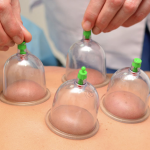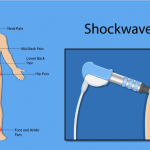WHAT TO EXPECT WHEN YOU ARRIVE
Parking is available on the left side of the building, or the right side of the building (in front of Shag Hair Salon).
We have two entrances. Either the side entrance through our state of the art PEAK Performance Training Center OR you can choose to walk down the back ally where you will enter directly into our Physical Therapy studio. You will see a green awning over the door.
Once you enter, relax, and mentally prepare for a great Physical Therapy Session.
Proper attire is only going to help you benefit further from the physical therapy session. Loose fitting tops/tank tops, sports bras, and shorts or loose fitting pants help to allow for the best hands-on treatment.

Manual Physical Therapy
This is just another way of saying Hands on Therapy. In many cases, therapists have their hands on the patients for 10 minutes/session—sometimes, even less.
In my office, we will be doing hands on therapy during the entire session. Years ago, ALL physical therapy was hands on manipulation, but over the years, the insurance companies have started to drive care. This is the reason why most therapists are juggling two and three patients at once, and often passing patients on to the aides and rehab techs. Brian Tenenhaus strives to spend each and every session in a one-on-one environment for the best possible care to each patient that he treats.

Performance Therapy
Performance therapy is an approach that bridges the gap between traditional rehabilitation and high-level performance training. It combines elements of physical therapy—such as manual therapy, targeted rehabilitation techniques, and movement analysis—with strength and conditioning principles. The goal is not only to help individuals recover from injuries but also to enhance their overall physical performance, reduce future injury risk, and optimize movement quality. This approach is commonly used by athletes or active individuals looking to return to sport or exercise at full capacity and improve beyond their general fitness or pre-injury levels.
In short, performance therapy supports a smooth transition from injury rehabilitation back to full activity and beyond, with the ultimate goal of helping you move and perform better.
Pricing and more information can be found under our “patient forms and resources” tab or feel free to give us a call or send us an online inquiry

Dry Needling
This is a technique that has been used for hundreds of years, all over the world. Just like many other types of medicine, it took a while until it was practiced here in the United States. Numerous studies have found that muscle fibers that are taut, painful, and in spasm, can cause significant pain, and also create what’s called referred pain. Myofascial Trigger Points have amazing referral pain patterns. Below are a few different examples as to how and why this is such an important technique to utilize as an adjunct of care.
Neck muscles can refer pain to the front of the face, surrounding the TMJ/ear and also around the eye socket. It happens all the time where somebody has continual pain in the front of the eye that gets misdiagnosed as a sinus infection. Not one, not two, but sometimes 3 bouts of antibiotics later, and somebody finally gives up on their primary care physician to take their care in a different direction.
Here’s another example, the subscapularis, (the muscle on the under surface of your shoulder blade) can refer pain down to the wrist, or the pectoralis muscles often refer pain down to the 3rd, 4th and 5th fingers and to the elbow. Who would have thought that wrist pain could have been coming from the muscle on the shoulder blade? These areas MUST be addressed, because many Doctors automatically assume you have Carpal Tunnel Syndrome.
How about tennis elbow? That is almost always explained as being a tight, overused muscle in the forearm, but it could be a trigger point coming from the triceps, the pectoralis major, or even the rhomboid muscle.
If the patient agrees to it, Dry Needling is often integrated into the Physical Therapy sessions, as needed. However, Dry Needling is ALSO available as an “A la Carte” service. Those who sit at a desk all day, cyclists, runners, and other athletes have all found it to be incredibly helpful.
Each session lasts approximately 30 minutes at $68.00 (can be billed through insurance as an OUT of Network physical therapy session)

Cupping Therapy
Cupping therapy is a traditional therapeutic technique that involves placing suction cups on the skin to create a vacuum effect. This suction
helps to improve blood flow, release muscle tension, and promote healing.
Glass, silicone, or plastic cups are placed on the skin. The vacuum effect can be created through heat (fire cupping) or a mechanical pump. Cups are left on the skin for 5-15 minutes, depending on the treatment goals.
Cupping therapy can:
- Improve circulation
- Detoxify
- Relieve muscle tension
- Improve skin health
Cupping therapy can create a sensation of tightness or pressure but generally should not be painful. If pain occurs, notify the therapist immediately.

Extracorporeal Shock Wave Therapy (ECSWT)
Extracorporeal Shock Wave Therapy (ECSWT) is a non-invasive therapeutic technique used in physical therapy and orthopedics. It
involves the delivery of shock waves to injured parts of the body to promote tissue healing and pain relief. ECSWT is based on the principle
that shock waves can stimulate metabolic reactions and enhance blood circulation, facilitating the repair of damaged tissue.
Benefits:
- Pain Reduction: ECSWT is effective in reducing pain from various musculoskeletal conditions.
- Tissue Healing: It promotes tissue regeneration and healing by increasing blood flow to the affected area.
- Non-Invasive: As a non-invasive treatment, it reduces the risk of complications and infections associated with surgical interventions.
- Mobility Improvement: It can help restore mobility in patients with conditions like tendinopathies, plantar fasciitis, and shoulder pain.
- Reduced Need for Medication: By providing effective pain relief, ECSWT can reduce the reliance on pain medication
- ECSWT is indicated for a variety of musculoskeletal conditions, including but not limited to:
- Plantar fasciitis
- Lateral epicondylitis (tennis elbow)
- Tendinopathies (Achilles, rotator cuff)
- Calcific tendinitis of the shoulder
- Greater trochanteric pain syndrome
- Patellar tendinopathy

Blood Flow Restriction Training (BFR)
To improve muscular strength and size it has been assumed heavy loads must be lifted. Unfortunately, in certain populations, like older individuals, post-operative patients, or those rehabilitating an injury, high-load exercises can cause injury and not be tolerated.
Blood Flow Restriction (BFR) training is a technique in which combines low-intensity exercise under reduced arterial flow conditions. BFR is quantifiably and objectively reducing the amount of blood flow into an extremity by using a specially made medical tourniquet. BFR allows
individuals to use low loads yet achieve results like high intensity training.
There are many mechanisms for improving strength and size of a muscle with BFR. Many of these mechanisms overlap the mechanisms from high intensity lifting. By decreasing the amount of blood flow into the muscle (from cuff restriction), the limb becomes hypoxic (lack of oxygen). In addition, the cuffs prevent blood from leaving the limb so swelling of the limb occurs. The following mechanisms have been described as contributing to adaptations from BFR training:
-
- Metabolic Stress
- Activation of Myogenic Stem Cells
- Release of hormones like Growth Hormone and Insulin Growth Factor
- Hypoxia
- Cellular Swelling
Although the exact mechanisms are not currently known, there appears to be a mixture of many mechanisms that contribute to early muscle size and strength gains when oxygen is reduced in the working limb.
BFR training is the ultimate biohack. BFR allows users to lift light weights and still achieve muscular gains and aerobic capacity changes similar to high intensity training. BFR can be a complete game changer for those who cannot tolerate heavy loads to maintain strength and muscle size over a lifetime.

Comprehensive Run Analysis
Run Analysis: Did you know that most runners have or will have some sort of injury or pain, that hinders their training? Have you ever watched yourself run? This physical therapist is not just a movement analyst, but he has just recently finished his first Ironman. (That’s 2.4 miles of swimming, 112 miles on the bike and a marathon to round out the day). He’s experienced plantar fasciitis, Achilles tendonitis, and shin splints first hand. Come get your run looked at and see what could be holding you back from your next PR!
Pricing
Bronze Medal Running Package: a one time deal (includes a packet with several pictures of your running, a customized schematic of your corrective exercises and a 45 minute discussion/treatment session outlining what it will take to get you to the next level.
$199.00 (can be billed through insurance)
Gold Medal Run analysis includes the above package in addition to 2 physical therapy treatment sessions to help reduce your dysfunction, increase your efficiency, and manipulate your body alignment (may also include dry needling if needed) to get your best pain-free running results!
$420.00 (can be billed through insurance as 2 Out-of-Network therapy sessions)

On Court Tennis Analysis
Have you ever had a physical therapist come to your tennis lesson or match to analyze your swing, your serve, your court movement. This physical therapist not only played Division 1 tennis, but he also has taught over 12 years of tennis locally and in Northern Virginia as well.
Experience a “one of a kind” tennis analysis session that starts with your PT observing you on the court in a tennis lesson for 1 hour followed by a 45 minute integration of video motion analysis. After that, take it into the treatment room and get your dysfunction treated so that it comes full circle and improves your tennis skill set, the next time you get on the court.
Pricing
On-Court Analysis offers a 1 hour and 45 minutes analysis for $250.00. This can be billed through insurance as an Out-of-Network therapy session.

Custom Orthotics
Your feet are the first thing to hit the ground, with every step that you take. If your feet are not supporting your frame, than that is setting you up for failure. Orthotics are molded to your feet, to create a more efficient support of your arch. If you asked me “do you like orthotics?” My answer would be simple.
“For some people, where they are at in their life, orthotics will make a significant difference in reducing their pain, and ultimately, changing their life. Orthotics will help take pressure off of your back, hips, knees and even your neck. They will also help to put you in a proper alignment, starting at the heel bone, and working its way up the chain.”
However, they are not for everybody. Some people will not do well with orthotics, and Brian will deal with each case accordingly. Oftentimes, the orthotics will not be something that you have to use for the rest of your life, but rather, a supplement to your physical therapy. They can be used to bridge the gap, and to help get you out of that pain cycle.
Ideally, you will be given exercises that are used in conjunction with manual therapy, to restore your arch and create the most efficient foot posture and alignment. At this point, if your alignment is still inefficient, or you still have too much pain with running, walking, or during your every day activities, the orthotics can be an excellent adjunct.
